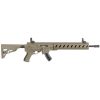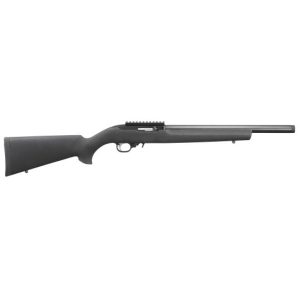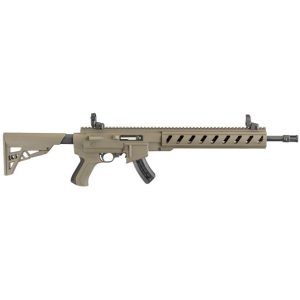Ruger 45221 .22LR Semi-Auto Rifle, 18.5" Barrel, Black – 21149 For Sale
$504.99
The Ruger 45221 .22LR Semi-Auto Rifle (Model 21149) features an 18.5″ barrel in a sleek black finish and is renowned for its consistent and reliable performance thanks to the legendary 10/22 action. It is designed with an easy-to-use extended magazine release for smooth removal of flush-mounted magazines. The rifle’s cold hammer-forged barrel, securely locked into the receiver using a unique two-screw V-block system, ensures exceptional accuracy and durability. Ideal for both novice and experienced shooters, this rifle exemplifies Ruger’s commitment to innovation and precision.
What Ruger 22 pistol do Navy SEALs use?
Navy SEALs have been known to use the Ruger Mk III and Mk IV pistols, specifically modified versions for suppressed use. These pistols are valued for their reliability and accuracy in a .22 caliber platform, often equipped with suppressors for stealth operations.
Why did Ruger stop making the 44 carbine?
Ruger discontinued the production of the .44 Carbine for several reasons. One primary factor was the rising cost of manufacturing the rifles, which made them less economically viable. Additionally, the design of the .44 Carbine was not as adaptable to modern advancements and customer preferences as newer models, leading Ruger to focus on more versatile and economically efficient firearms. Changing consumer demand and the evolution of hunting technologies also contributed to the decision to stop production.
Is the Ruger 10/22 discontinued?
No, the Ruger 10/22 is not discontinued. It remains a popular line of semi-automatic rifles produced by Sturm, Ruger & Co.
What are the most common Ruger .22 malfunctions?
The most common malfunctions for Ruger .22 firearms, such as the Ruger 10/22 or Ruger Mark series pistols, typically include:
1. **Failure to Feed:** This can occur when a round does not properly load from the magazine into the chamber, often due to magazine issues or dirty ammunition.
2. **Failure to Eject:** This happens when a spent casing is not properly ejected from the chamber, which could be caused by a dirty action, extractor issues, or using low-quality or underpowered ammunition.
3. **Failure to Fire:** This malfunction occurs when the firearm fails to discharge a round, often due to faulty ammunition, light firing pin strikes, or a dirty firing mechanism.
4. **Stovepipe:** This is a type of failure to eject where the casing gets stuck in the ejection port, resembling a stovepipe sticking out of the firearm. It can be resolved by ensuring the gun is clean and using proper ammunition.
5. **Double Feed:** This occurs when two rounds attempt to enter the chamber simultaneously, usually due to magazine or extractor issues.
Regular maintenance, proper cleaning, and using quality ammunition can help mitigate these common malfunctions.
What pistol do most Navy SEALs carry?
Most Navy SEALs commonly carry the SIG Sauer P226 or its variant, the P226 MK25, as their standard-issue pistol.
What .22 does the military use?
The military primarily uses larger caliber firearms, but for training and specific purposes, they may use .22 LR (Long Rifle) firearms. One example is the use of the .22 LR conversion kits for M16 rifles, allowing soldiers to practice marksmanship at a lower cost and with less recoil. Additionally, military and specialized units might use .22 caliber weapons for specific training exercises or operations requiring low noise and minimal recoil. However, these are not standard issue firearms and are used more for specialized roles.
What gun company did Ruger just buy?
Ruger recently acquired the Marlin Firearms brand from Remington Outdoor Company as part of a bankruptcy auction that concluded in late 2020.
What is the difference between the Ruger Deerfield and the 44 carbine?
The Ruger Deerfield and the Ruger .44 Carbine are both semi-automatic rifles chambered for the .44 Magnum round, but they have several key differences:
1. **Design and Production:**
– The **Ruger .44 Carbine** was introduced in 1961 and was manufactured until 1985. It features a tubular magazine and a more classic stock design.
– The **Ruger Deerfield** was introduced later, in 2000, and was produced until 2006. It incorporates design features from the Ruger Mini-14, such as a rotary magazine, offering a more modern look and feel.
2. **Magazine Type:**
– The **Ruger .44 Carbine** has a fixed tubular magazine that typically holds four rounds.
– The **Ruger Deerfield** uses a detachable rotary magazine, which typically also holds four rounds but allows for quicker reloading.
3. **Barrel and Action:**
– Both rifles are gas-operated, but the **Deerfield** utilizes a short-stroke piston system similar to the Mini-14, whereas the **.44 Carbine** employs a different gas system modified from Ruger’s early designs.
4. **Weight and Handling:**
– The **Deerfield** tends to be slightly heavier than the original **.44 Carbine** due to its updated receiver and magazine design.
5. **Market Appeal:**
– The **.44 Carbine** gained popularity for its handling and reliability and remains a favorite among collectors.
– The **Deerfield** added features intended to improve its appeal to modern hunters and shooters, such as the semi-automatic action inspired by the Mini-14.
Overall, while both rifles share similar calibers and semi-automatic operation, they differ significantly in magazine design, aesthetics, and minor functional improvements made in the Deerfield.
Does anyone make a semi-auto 44 mag rifle?
Yes, Ruger manufactures a semi-automatic .44 Magnum rifle known as the Ruger Deerfield Carbine. However, please be aware that the availability of this rifle might vary, as production of certain models has been discontinued at different times. Always check with firearms dealers or manufacturers for the most current inventory and offerings.
Is the Ruger 10 22 on the banned list?
As of my last update, the Ruger 10/22 is not generally on the federal banned list in the United States. However, firearm regulations can vary by state and local laws, so it is important to verify the current status in your specific location for any updates or changes in legislation.
What does 10 22 in the rubber mean?
“10 22 in the rubber” is likely referring to a specific type or brand of tire, where “10” and “22” represent particular measurements or specifications. However, without more context, it’s challenging to provide a precise explanation. Typically, numbers on a tire indicate dimensions (like width, diameter, or aspect ratio), or they might refer to production codes, standards, or other specifications. If you have a specific brand or model in mind, those numbers might have more detailed meanings related to that specific product.
Can you convert a Ruger 10/22 to a 17 Mach 2?
Yes, you can convert a Ruger 10/22 to a .17 Mach 2 by using a conversion kit. These kits typically include a new barrel chambered for .17 Mach 2 and may also require a new bolt or bolt handle that accommodates the different pressures and dimensions of the .17 Mach 2 round. It’s important to ensure that the conversion components are properly installed and function correctly for safety and reliability. Additionally, due to the different cartridge size and performance, it may be necessary to adjust or replace the magazine for optimal feeding. Always follow manufacturer instructions and consider consulting a gunsmith if you’re not experienced with firearm modifications.
What 22 do Navy SEALs use?
Navy SEALs typically use the .22 caliber handgun known as the Mk 22 Mod 0, also called the “Hush Puppy.” This firearm is specifically designed for operations requiring stealth and is equipped with a suppressor to minimize noise.
What is the difference between Ruger 22 Standard and Mark 1?
The Ruger 22 Standard, introduced in 1949, was the first pistol produced by Sturm, Ruger & Co. It is often referred to simply as the “Ruger Standard.” The Mark I, introduced later in 1951, is essentially an evolution of the same design. The primary differences between the Ruger 22 Standard and the Ruger Mark I mainly involve minor improvements and variations in configurations available, such as barrel lengths and sights. Both models are part of the same basic family of semi-automatic .22 LR pistols, with the Mark I benefiting from the formative lessons learned from the original Standard model’s production and use.
What pistols do Seal Team 6 use?
SEAL Team 6, also known as DEVGRU (Naval Special Warfare Development Group), is known to use a variety of firearms depending on the mission requirements. One of the primary pistols used by SEAL Team 6 is the SIG Sauer P226, specifically the Mk25 variant. They also use the Glock 19 as a standard sidearm. SEAL Team 6 may have access to other specialized pistols based on operational needs, but the P226 and Glock 19 are among the most commonly reported.




Reviews
There are no reviews yet.